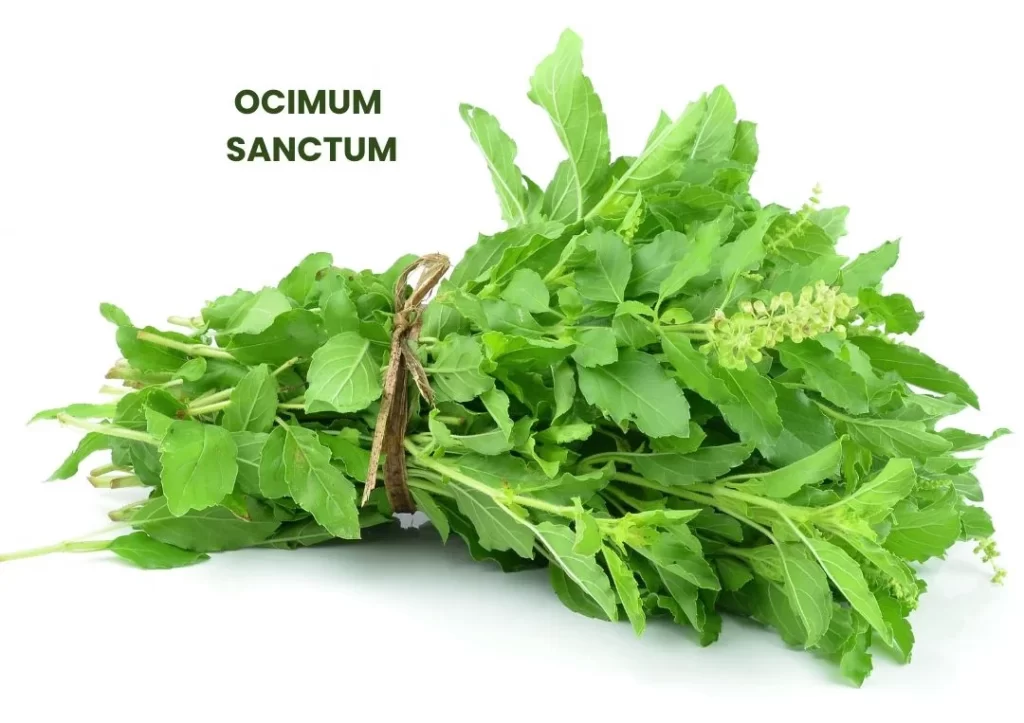Ocimum sanctum, commonly known as Tulasi or Holy Basil, is a revered medicinal plant in Ayurveda.
Known for its extensive therapeutic properties, Tulasi is considered sacred in Hindu culture and is often found in household courtyards.
It is highly valued for its medicinal properties, particularly in treating respiratory disorders, fever, and digestive issues.

SOURCE INFORMATION
Scientific Classification
- Kingdom: Plantae
- Clade: Angiosperms
- Clade: Eudicots
- Order: Lamiales
- Family: Lamiaceae
- Genus: Ocimum
- Species: O. sanctum
Origin and Historical Facts
- Tulasi is native to the Indian subcontinent and grows widely throughout Southeast Asia.
- In Ayurveda, it is known as “Vishnupriya,” meaning “the beloved of Vishnu.”
- Historically, Tulasi has been used for its adaptogenic, antimicrobial, and anti-inflammatory properties.
- It holds a significant place in traditional rituals and medicine, often regarded as a purifier of mind, body, and spirit.
DRUG PATHOGENESIS
- Ocimum sanctum exhibits various pharmacological actions, including adaptogenic, immunomodulatory, anti-inflammatory, and antimicrobial effects.
- The primary active constituents include eugenol, ursolic acid, carvacrol, linalool, and beta-caryophyllene, which contribute to its wide range of therapeutic benefits.
KEY CHARACTERISTICS
- Adaptogenic: Helps the body adapt to stress.
- Antimicrobial: Kills or inhibits the growth of microorganisms.
- Anti-inflammatory: Reduces inflammation.
- Immunomodulatory: Modifies or regulates one or more immune functions.
DETAILED ORGAN SYMPTOMS
MIND
- Forgetfulness: Lack of concentration.
- Disturbed Child: Crying and peevish behavior, does not like to lie in bed.
- Prostration and Drowsiness: Falling asleep while answering.
HEAD
- Headache: Heavy, throbbing pain, as if nails were driven into the head, relieved by pressure.
- Giddiness: Worse while walking, better by wrapping up the head; heat on the vertex better by pouring cold water and fanning.
EYES
- Pain and Redness: Lachrymation due to nasal catarrh; ophthalmia.
- Mist before Eyes: When focusing on something.
EARS
- Noise in Ears: Loud sounds appear very painful.
- Discharge: Watery or offensive pus from the ear.
- Shortness of Hearing: Hot flushes in the ear.
NOSE
- Nasal Catarrh: Sneezing, white or yellow discharge, ulcerated nostrils, epistaxis (nosebleeds).
FACE AND MOUTH
- Pale or Red Face: Bright red lips; watery salivation; putrid and bitter taste.
- Aphthae: Sores in the mouth; bright red tongue or sides with deeply coated middle; dry and black lips.
THROAT
- Pain: Difficulty in swallowing, pain while coughing, hoarseness.
CHEST
- Pain: Chest pain while coughing and sneezing; can’t lie quietly in bed due to asthma; pain in the middle of the sternum.
STOMACH AND ABDOMEN
- Flatulency: Eructation, hiccough, gurgling sounds in the abdomen.
- Lack of Appetite: Heaviness in the abdomen, no relief after stool; gripping pain in the liver or spleen.
FEVER
- Influenza and Fevers: Associated with cough, acute body pains, bone pains, muscle soreness, terrible headache.
- Typhoid Fever: Chills, burning sensation, delirium, drowsiness, and comatose condition.
STOOL
- Diarrhea: Copious, offensive, mucous or bloody, yellow or greenish; involuntary during high fever; more common in the rainy season or autumn.
URINE
- Involuntary Urination: Especially in children; burning while urinating; frequent desire to urinate.
FEMALE DISCHARGES
- Offensive Lochia: Long-lasting discharge after childbirth; profuse bloody discharge; leucorrhea.
MODALITIES
- Aggravation: Symptoms worsen with exposure to cold and damp weather.
- Amelioration: Improvement with warmth and rest.
WHAT ARE MODALITIES IN HOMOEOPATHY?
RELATIONSHIP WITH OTHER DRUGS
- Complementary: Works well with other adaptogenic and antimicrobial remedies.
DOSE
- Mother Tincture: For general use and acute symptoms.
- 3x: For chronic conditions and specific symptomatology.
Frequently Asked Questions
What is Ocimum sanctum used for?
- Ocimum sanctum is used for treating respiratory disorders, fever, digestive issues, and infections. It also has adaptogenic and immunomodulatory properties.
How does Ocimum sanctum help in respiratory conditions?
- It helps by reducing inflammation, easing congestion, and acting as an antimicrobial agent to fight infections.
Can Ocimum sanctum be used for mental disorders?
- Yes, it can help manage symptoms of stress, anxiety, and lack of concentration due to its adaptogenic properties.
What is the recommended dosage for chronic conditions?
- For chronic conditions, the potency of 3x is recommended, depending on the severity and specific symptoms.
Glossary of Difficult Words
- Adaptogenic: Substances that help the body adapt to stress and exert a normalizing effect upon bodily processes.
- Antimicrobial: Substances that kill or inhibit the growth of microorganisms.
- Antipyretic: A substance that reduces fever.
- Immunomodulatory: Capable of modifying or regulating one or more immune functions.
- Prostration: Extreme physical weakness or exhaustion.
- Lachrymation: Excessive tearing.
- Ophthalmia: Inflammation of the eye.
- Aphthae: Small ulcers on a mucous membrane, such as in the mouth.
This detailed drug picture provides a comprehensive overview of Ocimum sanctum, its medicinal properties, and therapeutic applications.
If you have any further questions or need additional information, feel free to ask!
